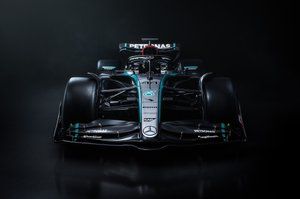The new directions McLaren has found with its evolutionary MCL38
McLaren surged up Formula 1's pecking order last year as multiple large-scale update packages helped rejuvenate a launch car that had proved to be a disappointment.
But, having placed so much emphasis on improvements last year, has McLaren reached the limit of its gains or is there still plenty of potential left in its package?
Unsurprisingly, the MCL38 is an evolution of the machine that raced in Abu Dhabi, albeit with the bodywork and components optimised to take further advantage of the performance accrued throughout the season.
Starting with the sidepods, the MCL38 features the down-sloping ramp-style bodywork at the rear, complete with a waterslide gulley that's been re-optimised to take into consideration the subtle changes made to the engine cover's shelf-like outcropping.
It's here where the cooling gill panels have also been condensed. However, given the panels can be interchanged we're only seeing one level of cooling here, with other options available depending on the amount of heat rejection required.

McLaren MCL38 sidepods detail
Photo by: McLaren
It's at the front of the sidepod where we see that McLaren is bucking the trend though.
Whilst most of the grid has followed the example of Red Bull and its underbite bodywork and shallow inlet seen on both the RB18 and RB19, McLaren has taken a different approach.
The inlet on the MCL38 is narrower and taller than expected. However, the sidepod still widens beyond the inlet to help tackle the turbulence created by the front wheel assembly.
What's more intriguing is the use of a short overbite instead, with the upper leading lip of the sidepod extending out and hooding the inlet.
McLaren may not be alone in having gone this direction because, if the shots of Red Bull's new RB20 being shaken down at Silverstone are to be believed, the world champion squad may have done this too.
Both squads changing direction would make sense, in as much as they are the two teams that have used the underbite for the longest. So they have likely found its weaknesses and moved towards a more appropriate alternative to increase performance.

McLaren MCL38
Photo by: McLaren
The MCL38 still features a pull-rod front suspension layout, with the arrangement undoubtedly refined to better suit the desired aerodynamic characteristics that link the front wing and nose assembly with the floor and sidepod region of the car.
And, whilst Mercedes, Aston Martin and Williams all appear to have made the switch to a push-rod rear this season, it's no real surprise to see the MCL38 sticking with that option too.
Both the MCL36 and MCL60 featured the arrangement owing to the Woking-based outfit not being reliant on Mercedes powertrains to supply it with a customer gearbox and rear suspension.

McLaren MCL38 detail
Photo by: McLaren
This allowed McLaren to tailor its layout to something more desirable for these regulations right out of the gate, with a premium placed on aerodynamics, at the expense of mechanical performance.
Of course, it's not a decision that comes easy though, as there are trade-offs for both layouts that have to be considered.
It's apparent that McLaren is also being coy about showing off its hand as there are discrepancies in some of the images, such as with the floor edge.

McLaren MCL38 floor differences
Photo by: McLaren
This suggests that it might have a new solution on the floor that we will either see if we get images from the shakedown or when the car hits the track in Bahrain for pre-season testing.
Meanwhile, the front and rear wings are direct descendants of the ones developed on the MCL60, which is not uncommon but does also suggest that there's more to come from the team, with Andrea Stella hinting as much in the press release:
"There are a number of innovations on the car, but not all the areas we want to address have been completed for our launch-spec car," he said. "Those areas now become the focus of our in-season development, which is already in progress."
Subscribe and access Motorsport.com with your ad-blocker.
From Formula 1 to MotoGP we report straight from the paddock because we love our sport, just like you. In order to keep delivering our expert journalism, our website uses advertising. Still, we want to give you the opportunity to enjoy an ad-free and tracker-free website and to continue using your adblocker.





















